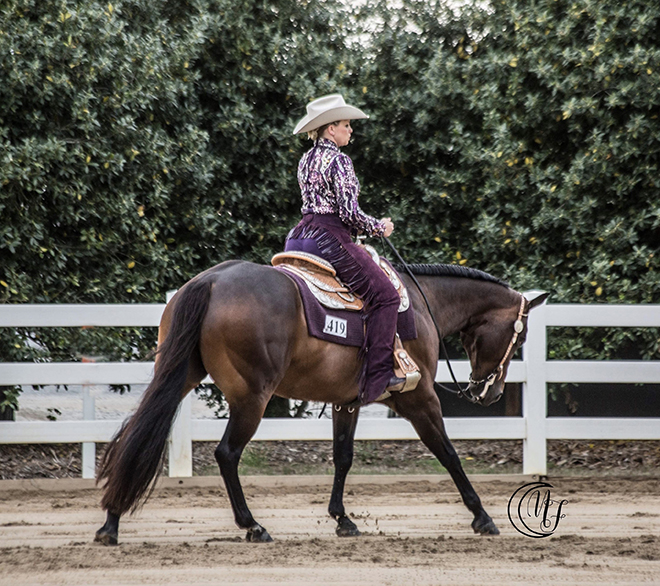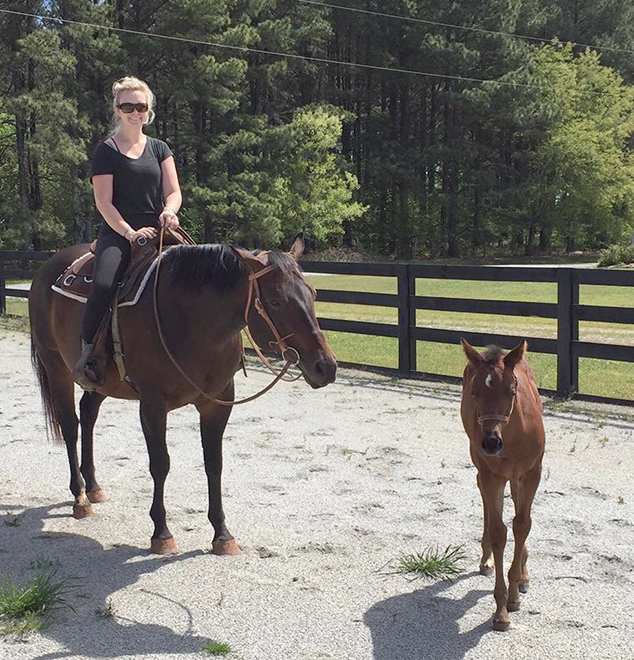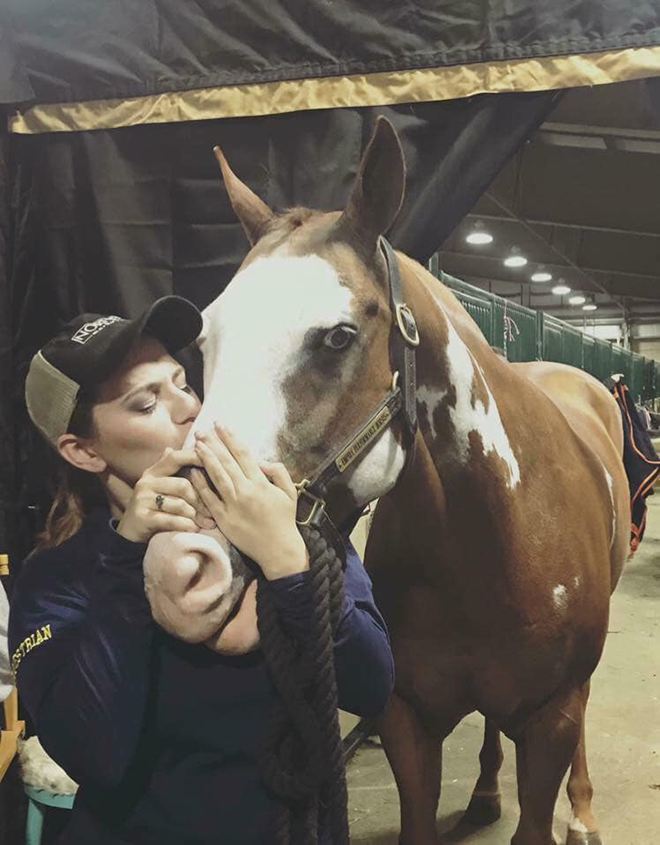
It’s tempting.
For one reason or other, the new dream prospect you spent all your savings on, hoping to develop into your next show partner, just doesn’t seem to want to go along with your plan.
So, after months, maybe years, you are tempted to give up and pull your old youth horse out of the pasture – and retirement – and make a comeback.
It may work. But it may also bring you heartbreak and cost a small fortune.
Trainers and owners who have been successful at bringing show horses out of retirement – and some who have failed, say before you take that leap, there are a lot of variables that you should consider.
In July 2015, The Love Machine, “Issac,” tore a deep digital flexor tendon. The gelding was being shown by a youth and had earned American Paint Horse Association (APHA) points in Halter, Showmanship, Western Pleasure, Horsemanship and Trail. Although he was only 5 at the time, he was retired to pasture. This spring he went to trainer Kristin Klimmek in New Richland, Minnesota. The former youth partner is now an adult who no longer rides, but his mom wanted to return to showing.
“The hope is that he will compete in all his previous events plus Hunter Under Saddle,” Klimmek said.
Issac has been back to work for about 60 days and has remained sound so far. Maintenance veterinary care, a strategic conditioning program and patience are the key to bringing horses out of retirement.
“Most horses have been retired because they are old or sore,” Klimmek said. “It’s going to be a slow process. Be patient and do it right.”

Good Time Blazer, “Sally,” was never supposed to be a show horse. When Georgia amateur Kelley Mundrick bought the then 4-year-old in 2013, she was broodmare sound. Her exact injury was unknown, but the mare had a hock/stifle issue. The next year Sally appeared sound and Mundrick decided to give her show experience before turning her into a broodmare. That fall she was Reserve champion at the All-American Quarter Horse Congress in Amateur Equitation. She earned three AQHA Superior awards that year and finished in the Top 5 at the Nationals Snaffle Bit (NSBA) Breeders Champion Futurity in the 3 to 6-Year-Old Non-Pro Trail.
Then she was retired and bred. In 2017, Mundrick’s show horse (Sally’s half-brother, A Rage In Good Time) became neurologic. Sally had her first foal that spring and was still sound. She was weaned in July and sent to Pinetree Quarter Horses in south Florida for conditioning. That year, Sally finished third at the NSBA World Show in Novice Amateur Trail and Amateur Equitation.
“She knew her job so it was just getting her back in shape without her getting hurt,” she said.
Not every horse is retired because of age or injury. Sometimes a rider’s circumstances change and the horse is retired. Kelsey Keathly bought Investors Norfleet, “Norman,” as a 2-year-old. She was 10 and the goal was to step up from open to breed shows. The pair competed in all-around events in Texas before moving to New York. When Keathly went to college, Norman was retired.
Knowing how your horse reacts, respiration and sweating wise (to work) are great keys to understanding their fitness level. A horse’s heart rate during recovery from exercise is another indicator of cardiovascular fitness. During exercise a horse’s heart rate can exceed 200 beats per minute. If the horse is fit for exercise the heart rate should return to less than 60 beats per minute within 10-15 minutes.
It’s also useful to determine the ratio of a horse’s heart rate to respiratory rate. The heart rate: respiratory rate should be 3:1 or 2:1. If this ratio approaches 1:1, the horse is overexerted or stressed and exercise should be stopped.
Equine athletes are just like human athletes. A person wouldn’t go run a marathon on the first day of training and a horse shouldn’t either. A slow, steady build up to fill work helps prevent injuries and burnout.
It takes a team
Show horses are elite athletes. Conditioning and training are essential to bringing a horse out of retirement. But routine veterinary and farrier care and therapeutic care are equally important. When Mundrick put Sally back into training she called the veterinarian out first. She had her hocks and stifles injected and she was started on Ulcer Guard.
“We wanted to make sure she felt the best and had every chance to make it back and feel her best,” Mundrick said.

Since many horses are retired because they are older and sore, chances are they’ll need more veterinary attention than younger horses who have never had soundness issues. Depending on the horse that may range from injections to chiropractic, massage and more. Norman is now 17 and part of his routine care includes regular Theraplate sessions.
“You have to be prepared to do some maintenance vet work on them along the way,” Klimmek said.
The length of time it takes to get a horse fit up after retirement largely depends on the horse’s age and body condition. The veterinarian who provides routine care for the horse can offer advice for a conditioning program tailored to the horse and accounts for past injuries or soreness. Rehabilitation facilities can also be a source of information when bringing a horse out of retirement.
Giving a horse time off isn’t always a bad thing. Even if injury or age doesn’t dictate retirement, a horse may benefit from prolonged time off. A mental and physical break can allow them to come back better than before and allow them to withstand showing long term.
“Sometimes I think a break is good for them, especially if they are hauling non-stop,” Mundrick said.
What the future holds
Only time will tell how long a retired horse will hold up in the show pen. It depends on the horse itself and how he is being used. Keathly hopes that with his light work routine and excellent veterinary care, Norman will eventually carry her daughter Kallie in her first leadline classes. He’ll be 23 by the time she’s old enough, but with routine maintenance, he should be in peak condition for the work load.
“When my daughter shows him, he’ll be shown by three generations – my mom, me and my daughter,” Keathly said.

For now, Mundrick says that Sally is retired once again and back to being a broodmare. But, she’s only 10, so there’s always a possibility she could be back in the show pen one day. So far, Issac is sound and back to work. This summer’s show season will determine how well his body healed from the injury several years ago.
“It’s going to be a slow process,” Klimmek said. “Be patient and take the time to do it right.”
In 2016, she decided to get him back into show shape. He ended up sixth in the nation in APHA Open Ranch Riding and had qualified for the World Show in Horsemanship, Showmanship and ranch riding.
At the 2017 Pinto World Championship Show, he enjoyed a retirement party with cake. But he couldn’t just stay idle. He’s currently with Adam D’Agostino at Albion College in Michigan as a lesson horse for the Intercollegiate Horse Show Association (IHSA) team.

“We’ve learned he can’t just sit,” she said. “He has to work and stay busy. Adam and Albion College take amazing care of him without pushing him too hard.”
Every horse is an individual. Some can step back into the same routine, others come back stronger than before. Others never make it back into the show pen.
“Don’t expect the world from them,” Klimmek said. “They were retired for a reason. Just because one comes back and starts winning doesn’t mean they all will.”
The proper conditioning program, good veterinary care and TLC can give each horse the best chance for going back to work. Read on to learn what worked for Keathly, Klimmek and Mundrick.
Ease into it
Returning to exercise after a layup is demanding. It takes nearly two months to build up muscle, but only two weeks off from a training routine to strip away muscle. Regardless of the length of layup, horses should be brought back to work slowly.
Some experts recommend two to three weeks of conditioning, others four to six weeks. A month allows the horse to undergo several cardiovascular, respiratory and metabolic adaptations that will greatly benefit their performance and help prevent future problems.
During the first two to three weeks of returning to work, the horse experiences cardiovascular changes, which improves oxygen delivery to the muscles. Metabolic changes also occur allowing the horse to more efficiently use energy from their rations and eliminate byproducts, such as lactic acid.
When Keathly took Norman to trainer Adam D’Agostino for help, he spent a lot of time trotting across the farm’s 600 acres.
“Riding him in the fields really got Norman to loosen up and use his body,” she said. “We didn’t do a lot of ring work at first. We did a lot of long trotting and trail rides to help Norman build his strength.”
When Klimmek first started Issac back to work, she did a lot of medium speed trotting to get him in shape. She started with 15 to 20 minutes a day and worked up to 45 to 60 minute rides increasing the degree of difficulty week by week.
“We did a lot of bending in his neck and pushing him forward into the bridle,” she said. “Then I started asking for more lift and slower speed at the trot and lope. Once he was in shape and remained sound we added pivots and lateral movements.”



You must be logged in to post a comment Login